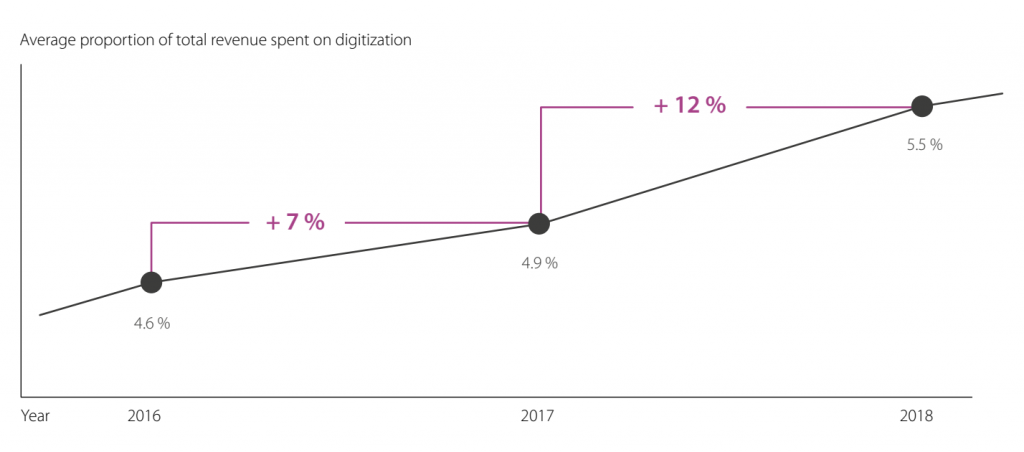
Corona crisis. Curfews. HomeOffice, wherever possible. All measures to slow the spread of the coronavirus. But what does it mean for efficient and effective cooperation? Are we – the companies and their employees – meaningfully prepared for it? I know, not another blog post on this topic. I’ll try to be brief and yet give some impulses.
Introduction
The buzzword “digitization” has been accompanying all industrial sectors for some time. It is like the Damocles Sword that has long been hovering over the heads of companies. You could say that the Corona crisis has brought it crashing down on us. Additionally, the term “digitalization” is associated with many points like self-determined teams, change in work culture, increased efficiency, cost savings, collaborative working, etc. And, most of the time, everyone has his or her perspective on it.
So, now that the corona crisis is forcing us to work distributed, asynchronously: How well are we prepared for “digital” work?
Looking at the expenditure of many companies in recent years on the subject of digitization, one would have to assume that there are many mature concepts, tools, and processes in place right now. It raises the hypothesis that the current transition to remote, distributed, and interlinked work will be easy.
Let’s take a look at the statistics. Some reports show the current state of digitization. Let’s concentrate on Germany. Here I can recommend the report from studie-digitalisierung. What we see there – apart from a detailed view per industry – is an increase in digitization expenditure (Figure 1), a forecast of progress (Figure 2), and a breakdown of the digital technologies used (Figure 3).



What does this mean for “digital” work?
Well, for one thing, the good news is that companies are taking digitization seriously by allocating adequate budgets for it. Now for the bad news: Through the progress prognosis and technology usage (including further comments of the report) the focus of the companies becomes clear – a lot is about “tools and technologies” instead of the holistic view of change, interweaving and integration of processes and working methods with selected digital tools.
A part of it I have described in my previous blog post “The Digital Transformation – from the data-driven viewpoint“. I don’t want to go into the individual points again here, but try to become quite concrete. Let’s stick to the current case of the Corona crisis and HomeOffice. The question arises: Are we “digitalized” just because we use collaboration tools such as MS Teams, Slack, or Rocket Chat, store our data in the “cloud” or use different enterprise collaboration environments that are available in the company?
My hypothesis is: No, we are not. Whether the assumption is correct will be shown by the current test.
Why do I believe that?
Digitization – in the way and to establish a digital workplace – does not mean the procurement and provision of a tool. Just because we do videoconference doesn’t say that our way of working is truly digital. Because digitalization is about people and processes but not about tools. Thus, it’s about changing the angle of view -away from current operations and person-related tasks, towards an entity based way of thinking. This perspective means thinking about the individual entities and cross-functional areas within the company. In combination with the existing processes, a digital tool can then be chosen. Among a step-by-step implementation procedure, it can be interwoven with the working method such that diffusion into the company takes place.
In this context, digitization means the improvement of business processes with the help of information and communication technologies. The improvement of business processes – which include both internal and external processes – does not depend on the tool used, but on meaningful integration, the interweaving of technology with processes.
Therefore a simple self-test: are the processes in the company clearly defined? Are entities and teams known? Are there clear storage structures? Do procedures follow clear structures (e.g., frameworks)?.
Conclusion?
Digitization is a process of change. This process goes through different phases and has to struggle with resistance per se. Change always means leaving the familiar and learning new things. That means habits that we have learned will change, and we have to learn things anew. For many people, this is certainly a change. For this change management, you can use the change curve by Elisabeth Kübler-Ross and Richard Streich to visualize which emotional path has to be taken (Figure 4).

The curve itself has a particular course that is identical for all changes – but does not always have the same gradient or compression. This always depends on the extent of the change as well as on the character of each individual.
I want to get a little more into the curve. Once the initial shock of using a new tool, adjusting the way of working, etc. is overcome, we are in a state of euphoria (it’s something new and fun). The descent into the “valley of tears” follows through “resistance” and “anger”- things don’t work, you have to adapt your habits, and it’s merely unclear how certain things work. These resistances and annoyances have a direct influence on our motivation and productivity. A downward spiral takes place because we perceive this, and we are dissatisfied with the situation.
Having reached the lowest point, the “valley of tears”, things can start to improve again. Exactly: can. That is not always the case, but when new skills, insights, and conditions have entered the organization by then, you start to try things out, have a sense of achievement, and enjoy continuing. The momentum should be used to drive the change process forward.
I think this should be kept in mind by anyone who wants to change things.
So what can you do to achieve a digital workplace?
I don’t think there’s an all-round “follow the plan” concept here. It depends on each organization, its structure, and its people, which leads to successful digitization.
I believe that the introduction of tools alone is not the right way. So my recommendation is to think about the core entities first. Afterward, I would like to take a look at the processes and name workstreams and their work artifacts. On this basis, a data-driven perspective can be adopted (see “The Digital Transformation – from the data-driven viewpoint“), which helps to think about an ontology and terminology – i.e., the linkage of data and the uniform naming of objects. Building on this, a step-by-step approach with defined goals and feedback loops should be established.
What are the factors – but no guarantees – for a successful digital transformation?
I mentioned some of them in the upper section. I would like to briefly list further, particular topics that help to establish the integration of technologists and processes in the company:
- Define Ways of Working:
Define the framework for collaboration within the team – especially in the case of distributed, asynchronous teamwork. What are the rules for online meetings? What are the rules for chat histories? How do we organize the exchange within the team, and how does a handover take place? Which tool is used for what – and when? - Central communicated data storage structures:
Unification of the document management by a process & entity based filing. Preferably via metadata structure to replace folders and have only one file in the system. Thus, it also allows collaborative work on the document. - Standardization of working methods and integration of workflows for recurring processes:
What do we always do in the course of a process? Are there artifacts that we create again and again for an entity? If so, how can this work – or the result of the process – be digitally supported? - Change of perspective – Digital working worlds require digital thinking:
We must also create an appropriate awareness of this. This awareness is only possible through knowledge – the why is essential. But even the precise understanding of which entities exist in the company and which processes they go through. Only in this way is it possible to adopt a substance based view. - Knowledge:
Digital tools have dozens of functions. Knowledge building through training is essential to create acceptance. But also to reduce fears in case one does not know something. - Support structures:
Help – on the learned knowledge – must be available over several instances. Directly in the team, in the department, as a central knowledge store, etc. Therefore “key-user concepts” should be established. It also serves as a communication channel. - Digitization Project Team:
A central contact person for everyone, reporting directly to C-Level. Decisions must be able to be made independently and quickly – of course, with the involvement of the respective departments to find out their requirements. But the integration, the choice of tools, etc. for the “digital workplace” should be handled by the know-how of the digitization project team. - Defined go-live activities:
Open, transparent communication -when things happen. And how. In interaction with “knowledge” (user training, accompanying learning material, etc.) and the “support structures” (key users, retrospectives, etc.), rapid progress – in terms of acceptance and use – can be achieved. - Measure:
All initiatives – whether quantifiable or not, functional or non-functional – must be measured. Think about what the desired “outcome” should be and measure it. That is usually more difficult than measuring the “output”, but it helps enormously to identify weak points of the digitization project. There are helpful frameworks for this – GQM (Goal Question Metric), for example, is one of them.
Summary
Well, it remains to be seen how well the progress of digitalization is in line with the emerging HomeOffice activities. I think that now is an excellent opportunity to advance the topic “digitalization / digital workplace” in a targeted manner to have a head start later on.
What is important is that the topic of digitization – in whatever form – is not a project but a process. And processes depend on people – so keep them in focus.
The goal of digitization should be to create the interweaving of digital tools and processes to facilitate collaborative, collaborative, asynchronous, and distributed work. This objective offers scale possibilities that make daily work more efficient and opens up new opportunities.







[…] and efficiency – through meaningful digital concepts along the value chain (see Post “Corona crisis and digitalization – the Damocles Sword hovering overall” and “The Digital Transformation – from the data-driven viewpoint“), which […]